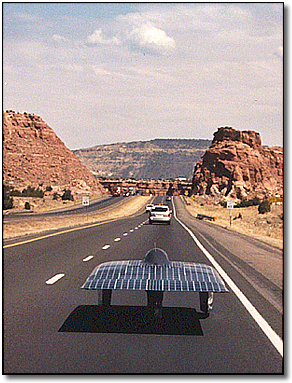
Image: University of Waterloo
 |
Past trips with
the solar powered car Midnight Sun VII have given Waterloo students
spectacular views from canyons to seacoast. Image: University of Waterloo |
"If we convince one person in North America to carpool for 10-years,
then they save as much carbon monoxide as we use for the entire convoy."
- Drew Ripley, Midnight Sun VII Public Relations
| Ontario, Canada -
August 7, 2004 [SolarAccess.com] How many college students does it
take to drive a solar car around North America in 40 days? At least six
drivers to steer Midnight Sun VII along the highways and back roads of
North America as students from the University of Waterloo in Canada test
the car's abilities and try to educate other drivers about the potential
of solar power. But the solar car, which was built, designed and
perfected by the students, needs more than drivers on the promotional
tour. A four-vehicle entourage will surround the solar car and driver as
the team starts the tour from the University campus. Of course, Public Relations Manager Drew Ripley has to answer to the fact that so many fossil fuel vehicles are used to try and promote renewable energy. "If we convince one person in North America to carpool for 10-years, then they save as much carbon monoxide as we use for the entire convoy," he said. The North American tour is far from the first time the Midnight Sun solar car has been on the road. Team members take the car to local racing events, science fairs and community gatherings to get the word out about solar power. Students from the University of Waterloo starting developing the car in 1988, and have raced different versions of the car in the North American Solar Challenge since that time. The challenge is a cross-country race of student built solar cars and sponsored by the U.S. Department of Energy. Waterloo placed with the top Canadian schools in the past two challenge races, but Ripley said they want to place in the top for the international competition in 2005. If they can make this 40-day tour, then they can probably win the race next year. A few last minute tweaks to the brake assembly were made before hitting the road, but the electrical system of the car is much the same as it was for last year's race. Junior Aaron Cheung joined the team this year to work on his skills as an electrical engineer. Text book learning hadn't prepared him for an aerodynamic car with a Kevlar body that is covered with eight square meters of 22 percent efficient Emcore solar cells. Storage batteries in the car are 36 kG of Kokam Lithium Ion Polymer, and regenerative breaking kicks some power to the batteries as well as the solar cells. For the first few weeks Cheung said he would just tinker with the systems to see how they worked. When he started to understand the car, however, projects to improve the car's performance were a simple matter of finding time between classes and schoolwork. If the project turned into a problem, the other team members were always ready to act as sounding boards for new ideas. "You face a problem for a long time and then you talk to someone else," Cheung said about the team interaction. "They give you an idea, so you say 'oh, that's how you do it'." Casual communication and late night work sessions are the norm when students are working in the lab at the university. On the road, they have to think quickly and clearly if something goes wrong with the solar car. All four of the support cars have to be ready to stop and do what's necessary to get everything back on the road. That could include directing traffic around a "pit stop" where the crew has to change a tire, Ripley said. Or making sure the whole team can find the proper place to get vehicle registration materials in the next state. The solar crew is as tight as a pit crew at the Indianapolis 500, he said. When they're not looking out for the next pot hole or toll booth, Ripley said the team will try and make some stops so the public can get a good look at the solar technology they've put on the road. Solar energy to power transportation probably isn't going to be viable for a long time, he said. But this tour should give people a good idea of the possibilities solar presents. Even if the team can't convince someone about the benefits of renewable energy, a successful trip around North American should have the new students ready to take on the North American Solar Challenge next year. "It's time that we push ourselves a little bit further," Ripley said. Midnight Sun VII leaves the campus of the University at Waterloo on August 7, 2004. Plans are to travel around North America and follow Interstate 95 between Washington and Maine. If the team can complete the trip, they will have traveled 19,000 km (11,780 m), which would give the team a place in the Guinness Book of World Records for the longest trip traveled by a solar car, according to Ripley. |
|
|
| For
Further Information: • Midnight Sun - University of Waterloo • North American Solar Challenge |
Please Note: SolarAccess.com and Arizonaenergy.org do not endorse the sites behind these links. We offer them for your additional research. Following these links will open a new browser window.
Copyright © 1999 - 2004 - SolarAccess.com
Please visit www.solaraccess.com for great coverage on energy today!!